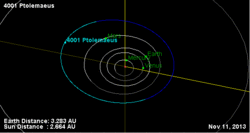Astronomy:4001 Ptolemaeus
 Orbit of 4001 Ptolemaeus | |
| Discovery [1] | |
|---|---|
| Discovered by | K. Reinmuth |
| Discovery site | Heidelberg Obs. |
| Discovery date | 2 August 1949 |
| Designations | |
| (4001) Ptolemaeus | |
| Pronunciation | /tɒləˈmiːəs/ |
| Named after | Ptolemy [1] (Greco-Roman astronomer) |
| 1949 PV · 1949 QD1 1982 BU9 · 1987 OE | |
| Minor planet category | main-belt [1][2] · (inner) Flora [3] |
| Orbital characteristics [2] | |
| Epoch 23 March 2018 (JD 2458200.5) | |
| Uncertainty parameter 0 | |
| Observation arc | 67.75 yr (24,744 d) |
| |{{{apsis}}}|helion}} | 2.6809 AU |
| |{{{apsis}}}|helion}} | 1.8940 AU |
| 2.2874 AU | |
| Eccentricity | 0.1720 |
| Orbital period | 3.46 yr (1,264 d) |
| Mean anomaly | 294.51° |
| Mean motion | 0° 17m 5.64s / day |
| Inclination | 5.4568° |
| Longitude of ascending node | 130.67° |
| 204.09° | |
| Physical characteristics | |
| Mean diameter | 4.641±0.297 km[4] 5.0 km (est. at 0.24)[5] |
| Geometric albedo | 0.392±0.056[4] |
| SMASS = S [2] | |
| Absolute magnitude (H) | 13.7[2] |
4001 Ptolemaeus, provisional designation 1949 PV, is a Florian asteroid from the inner regions of the asteroid belt, approximately 5 kilometers (3.1 miles) in diameter. It was discovered on 2 August 1949, by German astronomer Karl Reinmuth at the Heidelberg-Königstuhl State Observatory in Heidelberg, Germany. In 1991, the International Astronomical Union named the S-type asteroid after Greco-Roman astronomer Ptolemy.[1]
Orbit and classification
Ptolemaeus is a member of the Flora family (402),[3] a giant asteroid family and the largest family of stony asteroids in the main-belt.[6] It orbits the Sun in the inner main-belt at a distance of 1.9–2.7 AU once every 3 years and 6 months (1,264 days; semi-major axis of 2.29 AU). Its orbit has an eccentricity of 0.17 and an inclination of 5° with respect to the ecliptic.[2]
The body's observation arc begins with its observations as 1949 QD1 at Lowell Observatory on 24 August 1949, or three weeks after its official discovery observation at Heidelberg.[1] On 24 April 1989, Ptolemaeus approached the asteroid 6 Hebe within 5.5 million kilometers at a relative velocity of 3.7 km/s.[2]
Physical characteristics
In the SMASS classification, Ptolemaeus is a common, stony S-type asteroid, which is in agreement with the overall spectral type for members of the Flora family.[6]:23
Diameter and albedo
According to the survey carried out by the NEOWISE mission of NASA's Wide-field Infrared Survey Explorer, Ptolemaeus measures 4.641 kilometers in diameter and its surface has a high albedo of 0.392.[4] Based on a generic magnitude-to-diameter conversion, assuming a Flora-type typical albedo of 0.24, the asteroid measures 5.0 kilometers for an absolute magnitude of 13.7.[5]
Rotation period
As of 2018, no rotational lightcurve of Ptolemaeus has been obtained from photometric observations. Its rotation period, poles and shape remain unknown.[2]
Naming
This minor planet was named after 2nd-century Greco-Roman astronomer Ptolemy (Latin: "Ptolemaeus") by IAU's Minor Planet Names Committee. He is best known for his influential Almagest, a mathematical and astronomical treatise on the apparent motions of the stars and planetary paths. Its ideas dominated astronomy for 1200 years until Copernicus in the early Renaissance.[1] The official naming citation was published by the Minor Planet Center on 21 November 1991 (M.P.C. 19335).[7]
References
- ↑ 1.0 1.1 1.2 1.3 1.4 1.5 "4001 Ptolemaeus (1949 PV)". Minor Planet Center. https://www.minorplanetcenter.net/db_search/show_object?object_id=4001.
- ↑ 2.0 2.1 2.2 2.3 2.4 2.5 2.6 "JPL Small-Body Database Browser: 4001 Ptolemaeus (1949 PV)". Jet Propulsion Laboratory. https://ssd.jpl.nasa.gov/sbdb.cgi?sstr=2004001.
- ↑ 3.0 3.1 "Asteroid 4001 Ptolemaeus – Nesvorny HCM Asteroid Families V3.0". Small Bodies Data Ferret. https://sbntools.psi.edu/ferret/SimpleSearch/results.action?targetName=4001+Ptolemaeus#Asteroid%204001%20PtolemaeusEAR-A-VARGBDET-5-NESVORNYFAM-V3.0.
- ↑ 4.0 4.1 4.2 Masiero, Joseph R.; Mainzer, A. K.; Grav, T.; Bauer, J. M.; Cutri, R. M.; Dailey, J. et al. (November 2011). "Main Belt Asteroids with WISE/NEOWISE. I. Preliminary Albedos and Diameters". The Astrophysical Journal 741 (2): 20. doi:10.1088/0004-637X/741/2/68. Bibcode: 2011ApJ...741...68M.
- ↑ 5.0 5.1 "Asteroid Size Estimator". CNEOS NASA/JPL. https://cneos.jpl.nasa.gov/tools/ast_size_est.html.
- ↑ 6.0 6.1 Nesvorný, D.; Broz, M.; Carruba, V. (December 2014). "Identification and Dynamical Properties of Asteroid Families". Asteroids IV. pp. 297–321. doi:10.2458/azu_uapress_9780816532131-ch016. ISBN 9780816532131. Bibcode: 2015aste.book..297N.
- ↑ "MPC/MPO/MPS Archive". Minor Planet Center. https://www.minorplanetcenter.net/iau/ECS/MPCArchive/MPCArchive_TBL.html.
External links
- Asteroid Lightcurve Database (LCDB), query form (info )
- Dictionary of Minor Planet Names, Google books
- Asteroids and comets rotation curves, CdR – Observatoire de Genève, Raoul Behrend
- Discovery Circumstances: Numbered Minor Planets (1)-(5000) – Minor Planet Center
- 4001 Ptolemaeus at AstDyS-2, Asteroids—Dynamic Site
- 4001 Ptolemaeus at the JPL Small-Body Database
 |

